Each year, the Association for Research in Vision and Ophthalmology (ARVO) annual meeting gifts the eye care profession with a cornucopia of new research that let us see where the winds are blowing clinically. Here, we’ve compiled research specific to cornea and contact lens care we feel may be most impactful for practicing optometrists.
This year, the meeting was held entirely virtually, as researchers either presented their findings via video or with a virtual poster. The theme of ARVO 2021 was “the next revolution” in clinically translating research discoveries to restore and preserve vision. The findings summarized here are only a snippet of those presented at the meeting, but show the rich expanse of insights ARVO generates each year.
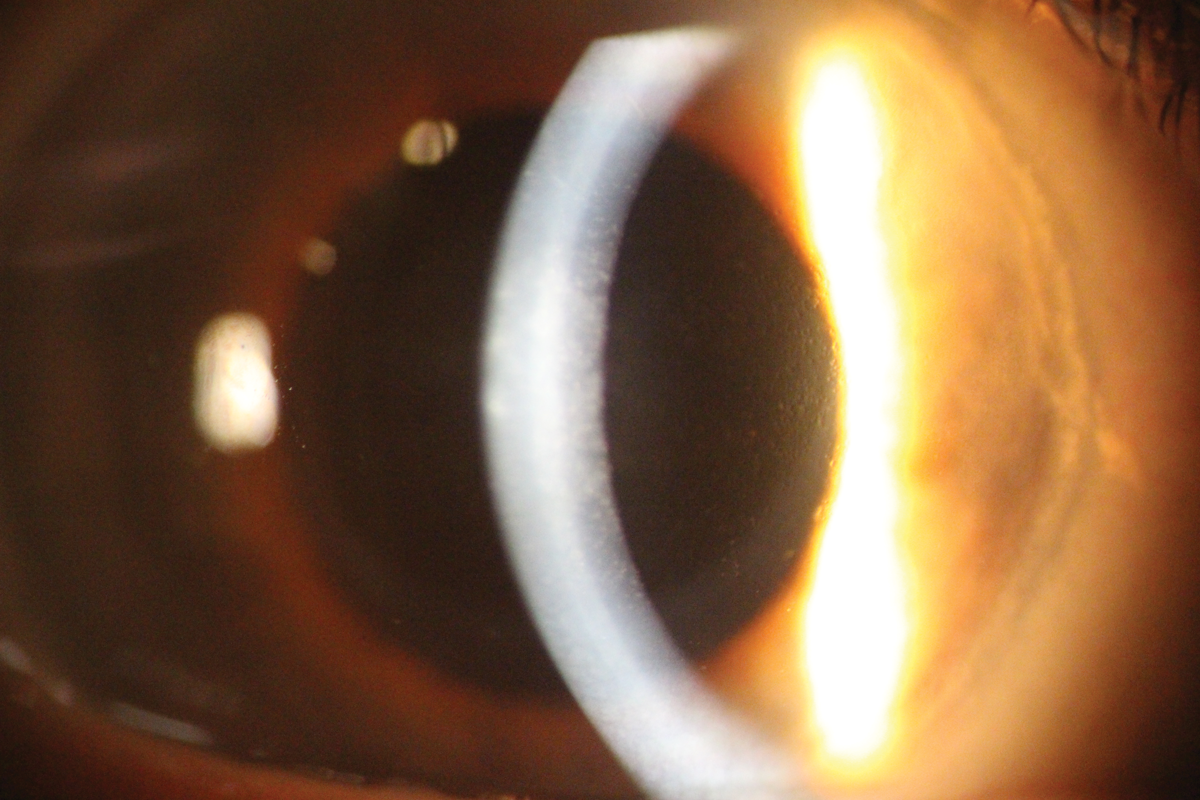 |
|
FECD elevates cancer risk in older patients. Photo: Mitch Ibach, OD, and Larae Zimprich, OD. Click image to enlarge. |
Corneal Disease
Several research teams took a close look at keratoconus risk factors and the systemic impact of Fuchs’ endothelial corneal dystrophy (FECD):
Keratoconus. According to new research, individuals short in stature may be at greater risk of developing spherical dioptric powers of 48.00D or greater—a hallmark of keratoconus. The researchers from the Icahn School of Medicine Mount Sinai in New York City also found that gender seemed to play a role in this relationship. They observed a higher prevalence in women than men.1
Using data from the National Health and Nutrition Examination Survey from 1999 to 2008, the investigators considered participants’ visual exam results, in addition to demographics and other ocular and body measurement information. The study included approximately 170 individuals with the keratoconus trait and about 20,000 controls.
The team used multivariate analyses, in addition to three separate models that assessed the keratoconus trait with BMI, height and weight.
The study reported a strong inverse relationship between height and the keratoconus trait in the pooled population and women. Specifically, for every one-inch increase in height, the researchers observed a 16% reduced risk of the keratoconus trait. In women, this was slightly higher, with a 19% reduced risk of the keratoconus trait for every one-inch increase in height, but the inverse association was borderline in men.
These findings can contribute to improved understanding of the pathogenesis of keratoconus, the study authors concluded.1
“Height may indeed be a ‘surrogate’ for more severe disease especially in females. Looking at genetic profiles has recently caught our attention with the introduction of approved genetic detection options,” says Joseph Shovlin, OD, of Northeastern Eye Institute in Scranton, PA. “This will definitely help guide us in the future with early interventions like corneal crosslinking.”
FECD. Older patients with this condition may be at greater risk of developing certain cancers, a team from the Mayo Clinic suggests. Their paper specifically found that Fuchs’ patients aged 65 and older appear to have an increased chance of malignancies of the breast, cutaneous basal and squamous cells and ovaries. On the other hand, they also may have a decreased risk of lung and prostate cancers.2
Genetics may play a role in these findings. It’s unknown whether FECD patients are at variable risk of systemic disease, but several other trinucleotide repeat expansion disorders, such as myotonic dystrophy type 1, are associated with increased cancer risk, the authors explained.
The investigation considered 1.5 million Medicare patients. Roughly 16,000 (about 1%) had an ICD code for FECD. The study included data from 2014 to 2016 and compared cancer risk between those with FECD and those without.
The researchers believe additional studies are needed to confirm this association, further explain potential disease mechanisms and identify genetic and environmental risk factors.2
Table 1. Cumulative in Vitro MIC90 Values for Staphylococci Collected in ARMOR (2009-2020)3 | ||||
| Antibiotic | S. aureus (n=2,599) | MRSA (n=900) | CoNS (n=2,143) | MR CoNS (n=1,041) |
| Besifloxacin | 1 | 2 | 2 | 4 |
Moxifloxacin | 4 | 16 | 16 | 32 |
| Gatifloxacin | 4 | 16 | 16 | 32 |
| Ciprofloxacin | 128 | 256 | 64 | 64 |
Levofloxacin | 16 | 128 | 128 | 256 |
Ofloxacin | >8 | 32 | 16 | 256 |
| Vancomycin | 1 | 1 | 2 | 2 |
Corneal Infection
Researchers determined new information on how viruses and bacterial species interact with the cornea.
COVID-19. The presence of SARS-CoV-2 RNA, spike and envelope proteins in the corneas of COVID-19 donors has been reported, but the presence of viral RNA and antigens hasn’t equated to infection. Researchers examined the replication ability of SARS-CoV-2 in cornea tissue of human eyes from affected patients and to understand the innate immune response.3
Eyes from healthy and COVID-19 donors were assessed in a variety of lab tests, including infecting primary human corneal epithelial cells from normal and diabetic donor corneas with SARS-CoV-2. Polymerase chain reaction testing assessed the expression of inflammatory and antiviral genes and confirmed RNA sequencing data in corneal tissue and cells.
RNA analysis showed the presence of both positive and negative strands of SARS-CoV-2 viral RNA in the epithelium of COVID-19 donor corneas. This coincided with infiltration of CD45+ cells in the stroma and induced expression of inflammatory and antiviral genes. RNA analysis revealed significant upregulation of genes involved in the viral response, inflammation and injury along with induction of factors involved in modulation of the immune response.
The study confirmed the presence of replicating SARS-CoV-2 viral RNA and antigen in the corneas of COVID-19 affected donors resulting in the production of inflammatory mediators and recruitment of CD45+ immune cells to the cornea.
Additionally, epithelial cells from diabetic patients increased SARS-CoV-2 replication and immune response, suggesting that diabetes is a potential risk factor for ocular transmission of COVID-19.
“We could detect replicating virus in the tissues with an antiviral response,” the authors explained in the abstract of their study.“Interestingly, the cornea tissue from diabetic patients had higher permissivity to viral infection and antiviral immune response—signs of productive infection. Therefore, our finding indicates that SARS-CoV-2 can infect and replicate in cornea tissue, and diabetes condition can increase the susceptibility and severity of COVID-19.”3
“How we get from corneal infection to systemic disease is something for future study, especially the risks,” Dr. Shovlin proposes. “It’s interesting to see the increased effects on the diabetic patient, which matches what we see in general with systemic disease.”
ARMOR 2021. Antibiotic resistance is one of the most pressing challenges to global health today, resulting in longer hospital stays, higher medical costs and increased mortality, according to the WHO.4
The long-running Antibiotic Resistance Monitoring in Ocular micRoorganisms (ARMOR) surveillance study informs clinicians of antimicrobial susceptibility patterns in ocular bacterial pathogens.5 Among ocular infections, gram-positive bacteria such as staphylococci are the most prevalent culprits.
The ARMOR investigators analyzed in vitro resistance among staphylococcal isolates collected between 2009 and 2020 (Table 1).5 The 12-year results indicated that staphylococci generally had minimal or no change in in vitro antibiotic resistance.
Researchers performed susceptibility testing on Staphylococcus aureus and coagulase-negative staphylococci (CoNS). The minimum inhibitory concentration (MIC) was defined as susceptible/resistant to 16 different antibiotics based on Clinical and Laboratory Standards Institute methods and breakpoints.
They found a significant decreasing trend in methicillin resistance (MR) among S. aureus but no change in MR among CoNS). Other significant decreasing trends were observed in resistance to azithromycin, ciprofloxacin and tobramycin, and to ciprofloxacin in CoNS. Trends in increasing resistance were reported in tetracycline among S. aureus and in trimethoprim for CoNS.
Multidrug resistance (three or more antibiotic classes) among MR strains remained prevalent in 2020, the researchers reported. No isolates were vancomycin-resistant, and besifloxacin retained “consistently low” minimum inhibitory concentrations during the study period.5
“On a positive note, vancomycin remains the gram-positive, methicillin-resistant treatment with best efficacy,” Dr. Shovlin notes. “There are obviously geographic differences in whether to use vancomycin initially or not.”
The investigators concluded that staphylococci demonstrated only minimal changes in antibiotic resistance; however, they cautioned about the small decrease in methicillin resistance in S. aureus, noting, “The high level of methicillin resistance in staphylococci warrants attention when selecting empiric antibiotic therapy, particularly with respect to multidrug resistance in these organisms.”5
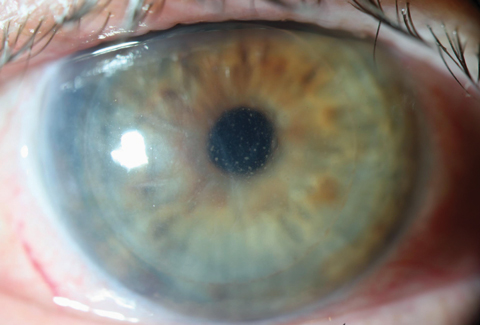 |
|
The 15-year failure/replacement rate of DESK was reported to be as low as 22%. Photo: Christopher Kuc, OD, and Richard Mangan, OD. Click image to enlarge. |
Corneal Surgery
Care and management surrounding surgical patients were explored in this year’s presented research.
DSEK. Endothelial keratoplasty has become the gold standard for treating corneal endothelial dysfunction, but long-term outcomes remain largely unknown. A research team reported Descemet stripping endothelial keratoplasty (DSEK) provided superior long-term visual rehabilitation and had a 15-year survival rate comparable to penetrating keratoplasty when performed for similar indications.6
The researchers, from the Cornea Research Foundation and the Price Vision Group of Indiana, also found DSEK failures within the first year were mostly associated with the learning curve at a time when techniques and instrumentation were still being developed and refined.
The retrospective observational study assessed 15 years of postoperative outcomes in 360 DSEK cases performed between 2003 and 2005 at a single center. The transplant indications included Fuchs’ (84%), bullous keratopathy (9%) and previous keratoplasty failure (7%).
At 15 years, 50 grafts had failed or been replaced (14%) and 136 (38%) were in patients who had died. Only 55 of the remaining 174 grafts (32%) were available for examination. The 15-year graft failure/replacement rate was 22%, taking loss to follow-up into consideration, the researchers noted.
Within the first year, 15 grafts were replaced due to early failure to clear (nine cases) or unsatisfactory vision associated with excessive graft thickness or wrinkles (six).6
“Lamellar surgery for endothelial disease appears to be an excellent surgical option with a low replacement rate at 15 years,” Dr. Shovlin says. “This group has advocated for chronic use of a topical steroid following any lamellar surgery which may account for the good extended outcomes to 15 years and beyond.”
ALK grafts. With better survival and lower rejection rates, anterior lamellar keratoplasty (ALK) has gained popularity as an alternative to penetrating keratoplasty to treat corneal stromal diseases. Because of this, researchers from Singapore evaluated the common protocol of donor/recipient age- and sex-matching on the outcomes of eyes that had undergone ALK surgeries.7
A total of 359 eyes from 322 patients who had ALK over an 11-year period were identified using graft registry data. Records show that 246 grafts were presumed compatible, 14 failed and eight were rejected. There were trends of lower hazard ratios in graft failure and rejection in the presumed compatible group.7
The study found that sex- or age-matching had no significant effect on ALK transplant rejection and failure. “However, the number of ALK surgeries performed that would be required to show such differences would be too large for any study to obtain,” the authors explained.7
“Future studies with pooled data may show a lower trend for rejection/failure using matched tissue and change the allocation recommendation for matches,” Dr. Shovlin says.
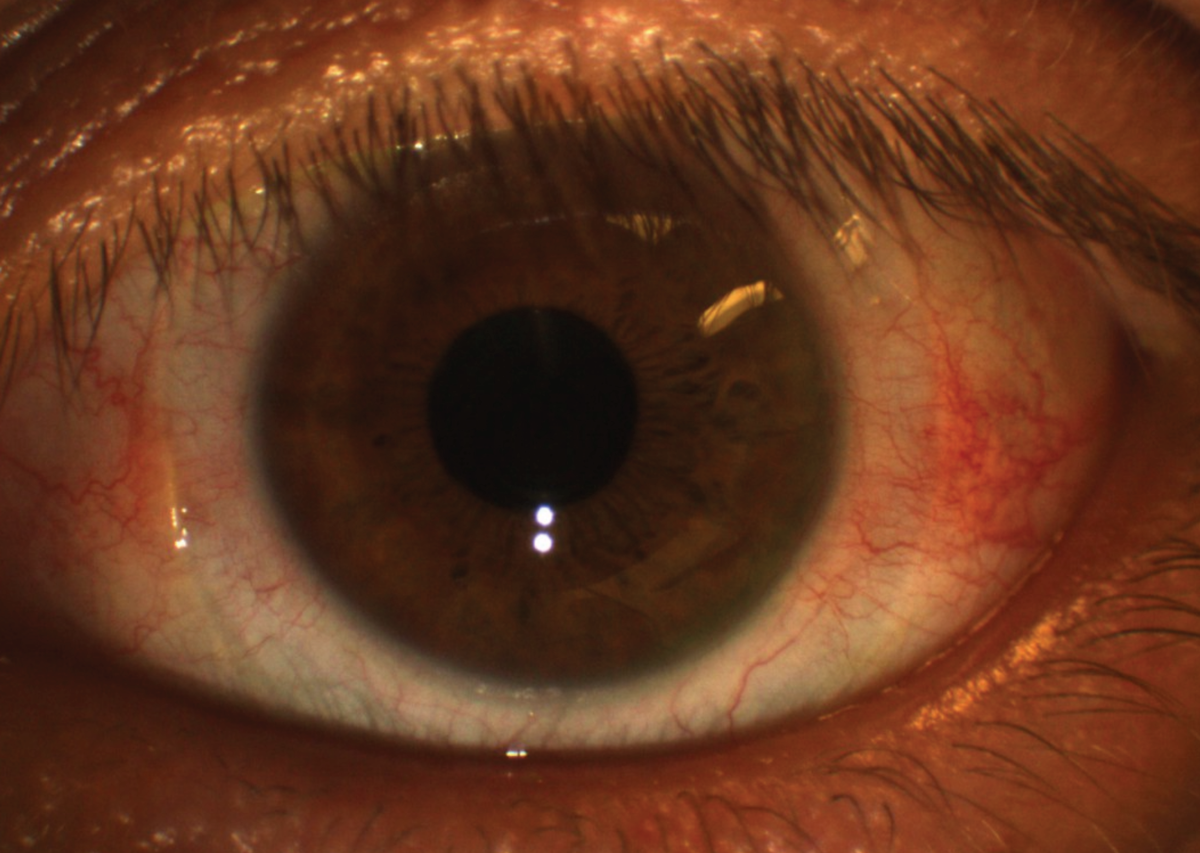 |
|
Both small- and large-diameter scleral lens designs induced some edema after an hour of wear. Photo: Maria Walker, OD.Click image to enlarge. |
Contact Lenses
One study explored corneal swelling with scleral lenses of different diameters. Researchers presented a study where they measured corneal thickness after short-term small- and large-diameter scleral lens wear.8
Twenty healthy participants were divided into two groups to measure change in corneal thickness after wear of either a 15.2mm or 18mm lens for one hour. Central corneal thickness was measured using the Pentacam both prior to lens wear and immediately after removal.
After an hour of small-diameter lens wear, corneal thickness increased by 1.2%; for those in the large-diameter lens group, the increase was 2.4%. Next, subjects switched to the other modality for one hour. Small-lens wearers had an additional 1.4% increase in corneal thickness after the change. Those who wore the large lens initially and then wore the small lens experienced a 1% increase.
“There is concern that scleral lens wear may cause the cornea beneath the lens to swell,” the researchers noted. “They also noted that differences in lens diameter and design may influence the corneal physiology differently.”8
“For now, maximizing oxygen permeability and working for ideal center thicknesses seems to be our best strategy to minimize long-term untoward changes as result of wearing scleral lenses; however, some of the new highly permeable materials have helped reduce these changes,” Dr. Shovlin says. “Corneal grafts continue to pose significant risk with reduced oxygen transmission sclerals and need to be watched carefully.”
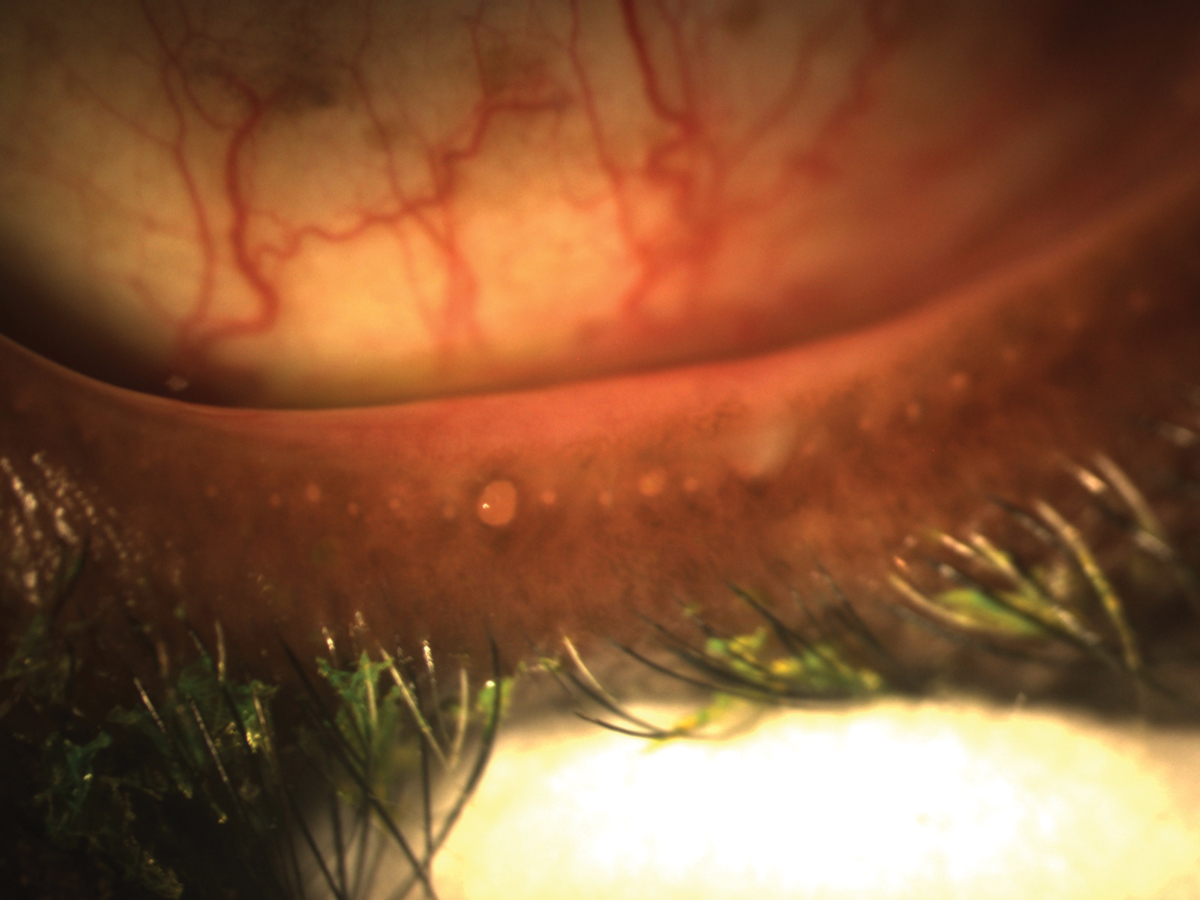 |
|
While statins had no effect on DED symptoms, some might reduce MGD. Photo: Doan Huynh Kwak, OD. Click image to enlarge. |
Dry Eye/Ocular Surface
Multiple studies exhibited new findings on patients at risk.
Osmolarity of refractive surgery patients. A retrospective study offered an analysis of the largest current sample of osmolarity in a normal population and post-refractive patients.9
In all, 1,404 patients undergoing screening for refractive surgery from 2017 to 2020 were reviewed. Routine exam included dry eye testing with osmolarity and the Ocular Surface Disease Index (OSDI) questionnaire. Patients were instructed to refrain from topical drops for at least two hours before the appointment.
Results indicated normal tear film homeostasis by osmolarity testing in 82.3% of eyes; post-refractive surgery patients indicated higher mean OSDI values compared with the remainder of the population.
The researchers concluded that a significant correlation exists between osmolarity scores and OSDI classification for the general population. Contact lens use correlated inversely with osmolarity and OSDI scores, while artificial tears correlated with OSDI scores in the post-refractive group only.
The authors noted that osmolarity and OSDI scores indicate that the majority of the standard population falls within normal ranges. “The impact of our findings may resonate” with surgeons and comanaging optometrists, “as a reasonable percentage of individuals will be diagnosed with tear film hyperosmolarity and represent a risk for reduced postoperative outcome and ocular comfort,” they concluded in their presentation.9
Statins and MGD. According to a number of studies, statins have an anti-inflammatory effect in addition to their cholesterol-lowering effect. Researchers at the University of Pennsylvania and the University of Tennessee examined the association between oral statin use and dry eye signs and symptoms. They reported that statin use wasn’t associated with severity of symptoms among moderate and severe DED, but noted that higher-intensity statins reduced MGD.10
The study was composed of participants from the DREAM study, a randomized multicenter trial that evaluated the effect of omega-3 supplements on dry eye treatment. The researchers collected self-reported statin use at baseline and classified it as low-, moderate- and high-intensity, based on the American College of Cardiology guidelines.
At baseline, 129 of the 535 DREAM study participants with moderate to severe DED reported statin use. Of these, 15 were low-intensity, 77 were moderate-intensity and 31 were high-intensity statin users. The team found statin users were significantly older than non-statin users (mean age 64.7 vs. 55.9).10
“Further analysis is needed to identify whether there is a specific type of MGD associated with intensity of statin use,” they concluded.10
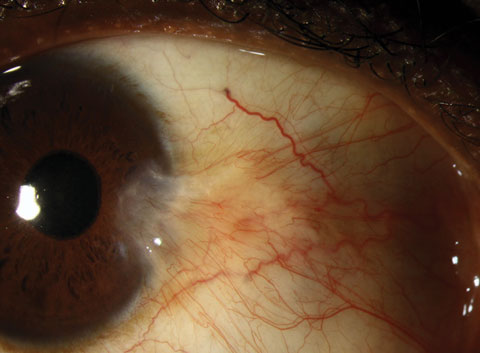 |
|
More than a third of pterygium recurrences develop after the first year. Photo: Christine Sindt, OD. Click image to enlarge. |
Blink patterns and tear film. Although meibomian gland structure and function can be assessed through meibography and lipid layer thickness (LLT), the role of blink parameters on the tear film is not as clear. A recent study suggested blink patterns may be able to predict which tear film parameters correspond to dry eye and can potentially guide treatment.11
The single-center, retrospective cohort study assessed 456 eyes and evaluated the relationship between LLT, meiboscore and blink rate, including the total number of blinks in 20 seconds, partial blinks and time between blinks.
For every one-point increase in the meiboscore, the average LLT declined by 1.31nm and the total blink rate decreased by 4%. Still, these findings weren’t statistically significant, the researchers noted.
Additionally, patients who had more complete blinks—or an incomplete blink rate less than 50% of the time—had shorter inter-blink intervals. “In patients with an increase in partial blinks, the longer inter-blink interval results from impaired corneal sensation related to the chronic exposure,” the researchers wrote in their paper.
The study also found no major difference in LLT in subjects with a partial blink rate greater than 50% vs. those whose partial blink rate was less than 50%.
“By carefully studying blink patterns associated with dry eye signs and symptoms, we may be better able to predict which parameters of tear film composition and blink function correspond to DED and potentially guide treatment,” the researchers wrote in their ARVO abstract.11
“In the future, clinicians need to continue to look at lid anatomy—by lifting, pulling and pushing on the lids—and assess the blink for the rate and amount of completeness in closure,” Dr. Shovlin advises.
Pterygium flare ups. DED also plays a role in pterygium recurrence. More than one-third of recurrences developed after the first year, which the researchers said highlights the importance of long-term follow-up in these patients.13
The study was conducted from 2017 to 2020 and analyzed the recurrence rate of conjunctival autografting with and without mitomycin C, as well as amniotic membrane grafting. Roughly 290 patients had pterygium, with 94 operated cases (32%). The investigation’s main outcome was pterygium recurrence over an average follow-up period of about 29 months.
Pterygium involving the cornea was found in 55% of cases. Gender also seemed to play a role, as females appeared to be more likely to have pterygium encroaching on the cornea.
The overall recurrence rate was 17% over a 14-month period, with pterygium returning 37% of the time after the first year. The only significant recurrence risk factor was DED.
Following conjunctival autografting with and without mitomycin C, patients had new pterygium flare ups about 16% of the time.
On the other hand, the recurrence rate following amniotic membrane grafting was almost double at 27% following conjunctival autograft, but the difference wasn’t statistically significant.
In participants who underwent conjunctival autografts, the addition of fibrin glue to their sutures didn’t lessen the chance that their pterygium would return.13
“Pterygium recurrence poses a major problem in ophthalmic care, and many strategies have been suggested over the years to minimize recurrences,” Dr. Shovlin says. “Minimizing DED appears to be a viable approach to minimize recurrences.”
This wonderful research will aid practitioners and provide useful information that could benefit their patients. Check out ARVO’s full listing of abstracts and posters to see for yourself the latest advances in eye and vision care.
1. Vallaru G, Hennick D, Klawe J, et al. Anthropometric measures and their relationship to a keratoconus-like trait in the US population, NHANES 1999-2008. ARVO 2021 Meeting. 2. Xu TT, Baratz KH, Fautsch MP, et al. Cancer risk in patients with Fuchs’ endothelial corneal dystrophy. ARVO 2021 Meeting. 3. Singh S, Wright RE, Garcia G, et al. SARS-CoV-2 infects human corneal epithelium and elicits an antiviral immune response. ARVO 2021 Meeting. 4. Fact Sheet: Antibiotic Resistance. www.who.int/news-room/fact-sheets/detail/antibiotic-resistance. Accessed May 3, 2021. 5. Asbell PA, Sanfilippo CM, DeCory HH. Analysis of longitudinal antibiotic susceptibility trends in Staphylococci: results from 12 years of the ARMOR Study. ARVO 2021 Meeting. 6. Price M, Price F. Descemet stripping endothelial keratoplasty: 15-year outcomes. ARVO 2021 Meeting. 7. Ong HS, Chiam N, Htoon HM, et al. The effects of donor-recipient age and sex compatibility in the outcomes of anterior lamellar keratoplasties. ARVO 2021 Meeting. 8. Nau CB, Shorter E, Schornack M, et al. Corneal swelling after one hour of small and large diameter scleral lens wear. ARVO 2021 Meeting. 9. Xuan R, Lawless M, Sutton G, et al. Tear film osmolarity in a cohort of 1404 patients undergoing refractive surgery assessment. ARVO 2021 Meeting. 10. Yu Y, Maguire MG, Roy N, et al. Association of oral statin use with dry eye symptoms and signs in the DRy Eye Assessment and Management (DREAM) study. ARVO 2021 Meeting. 11. Brahmbhatt P, Brahmbhatt S, Adams W. Lipid layer thickness, blink parameters and meiboscore in patients with dry eye disease: a retrospective cohort study. ARVO 2021 Meeting. 12. Zhu C, Weiss M, Scribbick F, et al. Prevalence of conjunctival intraepithelial neoplasia in pterygium specimens. ARVO 2021 Meeting. 13. Alsarhani W, Alshahrani S, Showail M, et al. Characteristics and recurrence of pterygium: a single center study with a long follow-up. ARVO 2021 Meeting. 14. Qian X, Li Y, Musch DC, et al. The critical period of myopia, insight from the myopic shift in school age children after COVID-19 home confinement. ARVO 2021 Meeting. |


